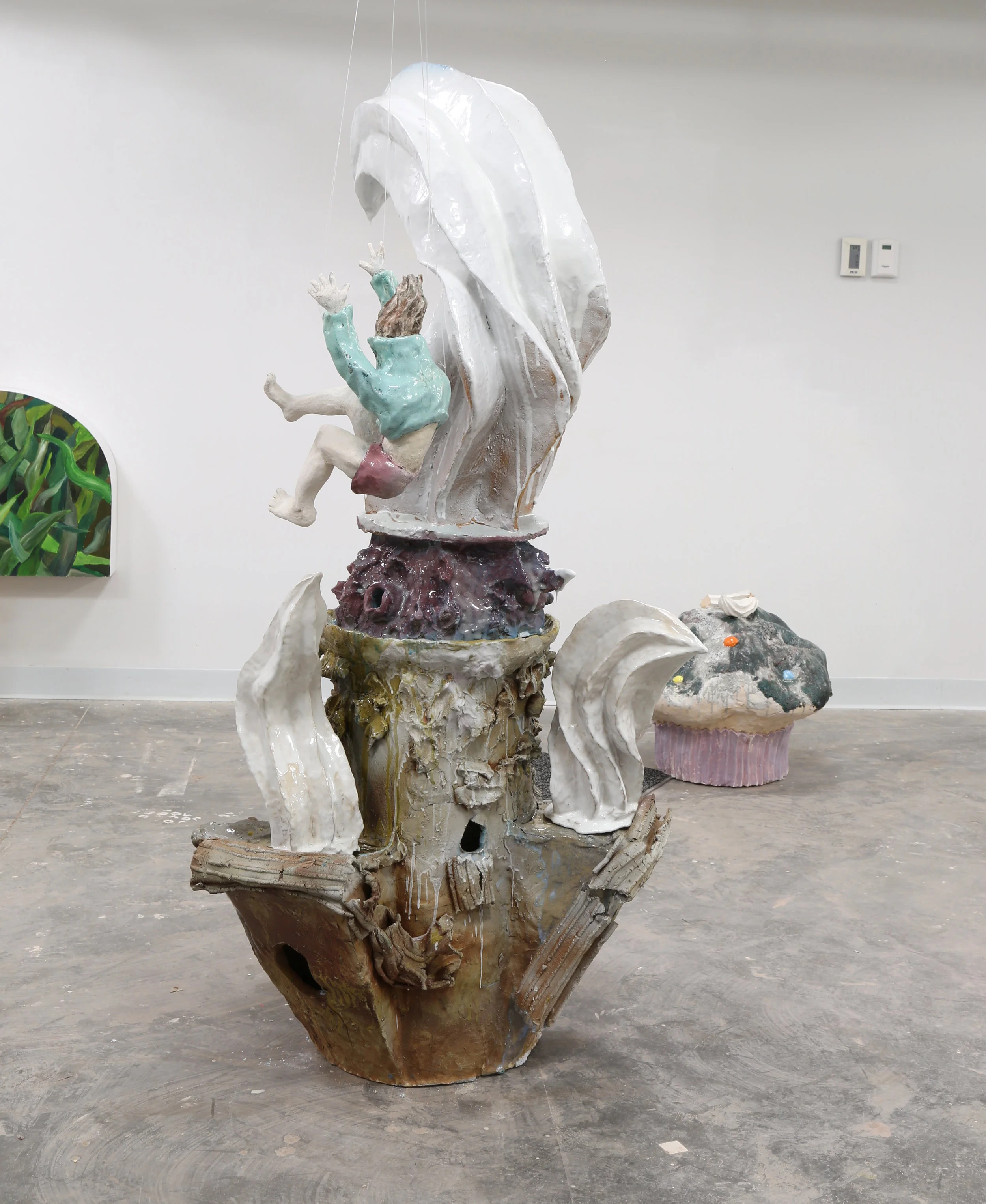Interview with Nora Arrieta
Nora Arrieta
Falling Asleep, 2018
Ceramics
19 x 19 x 68 in.
Nora Arrieta graduated with an MFA degree in Ceramic Art at the New York State College of Ceramics at Alfred University. Prior, she graduated in Sculpture from the Weissensee Art Academy in Berlin, and she was a Master’s apprentice of Martin Honert at the Fine Art Academy in Dresden and a Visiting Artist at Syracuse University. She has received several grants including the Mart Stam Award in 2014 and a DAAD Scholarship. In this interview, she goes in depth on her process and recent work with guest juror, Alice Bonnot, a London-based curator and art consultant.
Alice: You are currently undertaking an MFA in Ceramic Art at the New York State College for Ceramics at Alfred University, in Alfred NY, U.S. What made you want to study ceramics after getting an MA in Sculpture at the School of Fine Arts, in Dresden, Germany?
Nora: I explored ceramics during my studies in Germany and I fell in love with the softness of clay and the surface of glazes. But soon I felt a limitation because of the technical aspects and I wanted more control, especially with the glazes. The MFA program at Alfred University suited my needs of learning all the technical knowledge in ceramic sculpture and growing conceptionally by intensively studying with other artists working in clay.
Alice:How do both programmes influence, or have influenced, your practice?
Nora: In Germany, I was mostly focussed on the conceptual aspect of ceramics within the context of sculpture in general, and I was concentrating on the vessel form.
In Alfred, I have deepened these thoughts and ideas more specifically by studying ceramic art history and exploring the technical possibilities of the material. This extended approach of using clay and glaze has strongly affected my visual ideas and the potential of expression. I have also extended the space where the sculptural experience has happened.
Alice: With time, installation seems to have taken an important part of your work. How do you create a narrative between each ceramic piece and the other components such as films, paintings, and wood constructions?
Nora: In the space, the ceramic objects turn into protagonists of experience that the viewer has primarily with space. I am working with the concept of abundance and seek a sense of overload in my installations. The narrations are created playfully. I am working with different materials and media to have a range of meanings depending on these different components. The other medium answers visually and conceptionally to the ceramics and to each other. Here I create an open dialogue without having something very specific in mind at the beginning but with a rhythm of meanings and connections that structure the space.
Alice: At which stage of your creative process does the question of presentation or display occur?
Nora: Display plays an enormous role in my work. It changes the narrative potential of an object and forms the relationship between the different sculptures. In the making process of the pieces I have an image of the whole space in mind. However, the display is mostly still open until I start to install. The whole installation process is very exciting as the sculptures completely change when they leave the studio. Then, the space becomes a stage or a playground that I enjoy to fill with meanings.
Alice: Most of your sculptures, including Subway, Nowhere Fast, and Tree, are assemblages or fusions of everyday objects such as cars, shoes and subway chairs. How do you select each element?
Nora: The elements I use are mostly based on my thoughts about ancient iconography and how this can be transferred into a contemporary image. For example, the car is a metaphor for many things: It has relationships to the image of the home or house, with the addition of wheels underneath, it is the modern technology version of the horse, and it is a projection screen of desires regarding wealthy, status and mobility. Advertising imagery has a strong impact on my work because it represents a special mentality of our time towards purchasable goods. I investigate the question of celebration and desire and how these might have replaced religion.
But a lot of the imagery also comes directly from daily life into the work. By creating surreal landscapes like the Subway, where scale, color, and form are an expression of an emotion and a memory I visualize a subjective perception of reality and spaces. These environments are not only what we see but also virtual spaces like social media platforms or other two-dimensional imagery that affect our imagination and thus the perception of reality.
Alice: Do you work around specific themes or subjects?
Nora: Although my work has a lot of different imagery my themes have consistent anchors about questions of the relationships between human culture and nature. It is the question of longing for paradise. I am investigating the role of simple daily life objects in order to create an iconography and meaning around the subjects. For example, always returning subjects of mine are gardens, trees, and dogs. To me, gardens represent the desire to be close to nature but are modified to something artificial and human-made. Pets are similar: They are a reminder that we are still able to communicate with other creatures. At the same time, they are reshaped by humans, are dependent and becoming part of human culture.
Another theme is abundance, of food, of purchasable goods, of noises in cities, of the constant movement on social platforms. To me, the abundance of material goods, the noise, and the fast pace are the main characteristics of the contemporary experience.
Ceramic by itself is a theme too: It is sustaining and I consider the question of the value and perception of my images in the future. Ceramics have been always told us something about ancient cultures and I am driven by the idea of capturing the present and preserving it in a succession of historic material culture.
Alice: Nowhere Fast for instance can be seen as a dystopian scene where half the sculpture represents the garden Eden, guarded by a peaceful porcupine, while the other half is a big car, probably highly pollutant. Which comment is this piece making?
Nora: We can see sculpture always from different sides. In the same way
I don't want to give a one-dimensional perspective of a thought or a topic. In this piece, there is the general aspect of mourning about the destruction of the environment by human-made technology with the porcupine as a symbol of nature, and as a daily example of road kill in rural areas. But in our culture, the car also promises an idea of independence, power, and perfection, a paradise on earth. In the sculpture there are these two contradictions: We don't want to be evil but we also desire consumption and goods. This paradox is not necessarily judged but visually connected. It provides the viewer with an image to reflect on his own opinions.
Alice: Drawing is also part of your practice. How do you see it in relation to your ceramic sculptures and mixed-media installations?
Nora: Drawing is an important part of my practice. I make sketches from observation where reality is fragmented and mixed with fantasy. I work with clay the way how I draw: The aspect of gesture is very important as well as the aspect of time in the making process. When I started to make vessels I saw their surface like paper, an empty space, ready to fill with imagery.
I see my installations as big drawings that move into space. I want my installations to be artificial environments and give the viewer the same experience like getting lost into a detailed drawing.

